Installing HVR Hub on Windows using Zip File
This section describes the requirements and step-by-step instruction on how to install the HVR Hub System on Windows using Zip file.
For installing the HVR Hub on Windows using installer, see Installing HVR Hub on Windows using Installer.
For installing HVR Agent on Windows using installer or zip file, see Installing HVR Agent on Windows using Installer or Installing HVR Agent on Windows using Zip File respectively.
The installation file for Windows is available for download in .exe and .zip format. The compressed file (.zip) distribution is normally used as an alternative for the Windows executable based (.exe) distribution. Also, the installation steps are different on both formats.
Requirements
Following are the prerequisites for installing the HVR Hub on Windows:
Sufficient disk space
Ensure sufficient disk space is available on the machine where this installation will be performed. For more information, see Hub Disk Requirements.Compatibility
Check whether the HVR version is compatible with the operating system and DBMS. Refer to the relevant Supported Platforms section or read the COMPATIBILITY section in the release notes (available under the Downloads tab in the Fivetran dashboard).Installation file
HVR Hub System installation file for Windows (e.g. fivetran-6.1.0_21-hub_and_agent-windows-x64-64bit_ga_patch.zip). This file can be downloaded from the Downloads tab in the Fivetran dashboard. For more information, see Downloading HVR.Database for HVR repository
HVR uses its repository database to store the replication definitions (which tables must be replicated between which 'locations') as well as run-time status (which jobs are currently running). For databases supported as a repository, see section Repository Database.Access to source and target locations
For the HVR Hub System to access a source or target database directly, the database connectivity (e.g. ODBC drivers) must be installed on the hub machine. For more information, see Source and Target Requirements.Perl version 5.6 or higher must be installed. If Perl is installed after the installation of HVR Hub System, then the hub server service must be destroyed and recreated.
Windows user account privileges.
Elevated user account privilege is required for running the HVR Hub System executable/installer. Normally this means the user must supply an administrator password interactively.
The user account (e.g., fivetran) that will operate the HVR Hub System must have the Log on as a service policy enabled.
Click here for the steps to configure the user policy
User account policies can be managed using the Windows Local Security Policy console accessible from Control Panel ▶ Administrative Tools. Alternatively, you can use the secpol.msc command to open this console directly. For more information about enabling this policy, refer to the Microsoft documentation.
- In the Local Security Policy window, expand Local Policies and click User Rights Assignment.
- Double-click the Log on as a service policy available in the list of policies on the right pane.
- In the Log on as a service Properties dialog, click Add User or Group to display the Select Users, Computers, Accounts, or Groups dialog.
- In the Enter the object names to select field, enter the user account name that requires this policy, and click OK.
- Click OK.
Install Steps
Perform the following steps in the user account that will be used for operating the HVR Hub System:
Configure the environment variables HVR_HOME, HVR_CONFIG, and HVR_TMP for your operating system. Each of these environment variables should be pointed to the installation directories - hvr_home, hvr_config, and hvr_tmp.
Environment variables set using setx command are available in the future command windows only and the environment variables set using set command are available in the current command window only.
setx HVR_HOME C:\fivetran\hvr_homesetx HVR_CONFIG C:\fivetran\hvr_configsetx HVR_TMP C:\fivetran\hvr_tmpset HVR_HOME=C:\fivetran\hvr_homeset HVR_CONFIG=C:\fivetran\hvr_configset HVR_TMP=C:\fivetran\hvr_tmpAlso, add the executable directory path (e.g C:\fivetran\hvr_home\bin) to the environment variable PATH.
setx PATH "%PATH%C:\fivetran\hvr_home\bin"set PATH=%PATH%;C:\fivetran\hvr_home\binAlternatively, environment variables can be configured using Windows GUI.
Navigate to Control Panel ▶ System and Security ▶ System ▶ Advanced system settings
Alternatively, use the command sysdm.cpl to open System Properties.
In Advanced tab, click Environment Variables...
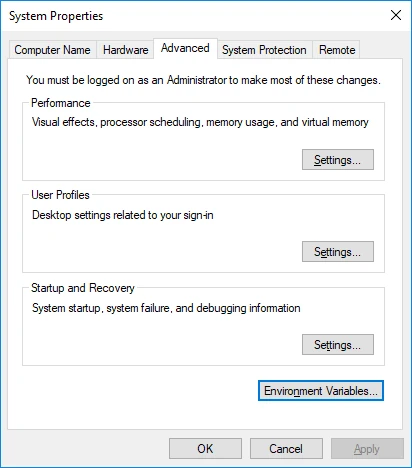
In the section System variables or User Variables for user_name, click New.
- Enter Variable name (e.g, HVR_HOME) and Variable value (e.g, C:\fivetran\hvr_home).

- Click OK.
- Repeated the above steps for each environment variable.
- Enter Variable name (e.g, HVR_HOME) and Variable value (e.g, C:\fivetran\hvr_home).
Add the executable directory path (e.g C:\fivetran\hvr_home\bin) to the environment variable PATH.
- In the section System variables or User Variables for user_name, from the list of variables, select Path and click Edit....
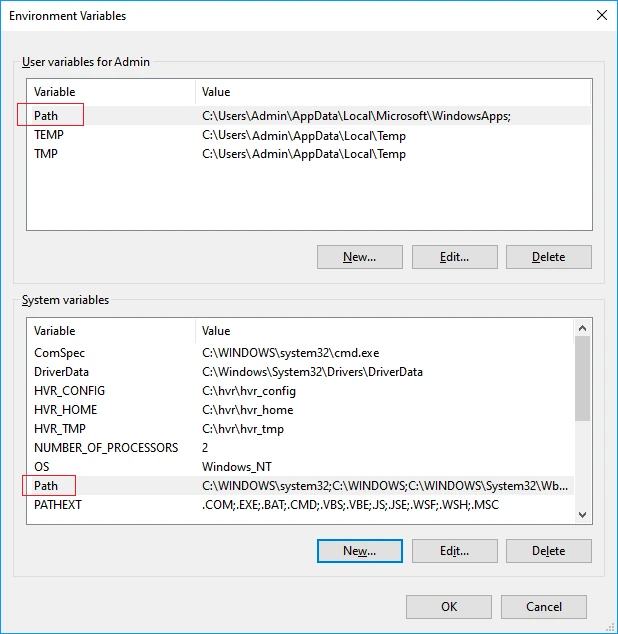
- Click New and enter the path for the executable.
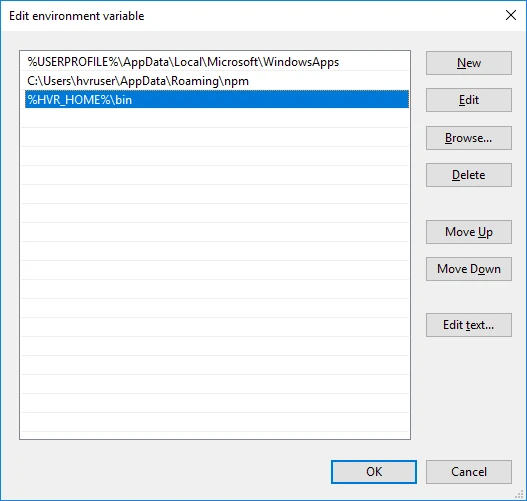
- Click OK.
- In the section System variables or User Variables for user_name, from the list of variables, select Path and click Edit....
Create the installation directory - hvr_home (e.g. C:\fivetran\hvr_home).
md %HVR_HOME%- other directories (hvr_config and hvr_tmp) will be automatically created as needed.
- hvr_home is regarded a read-only directory. The user files saved in this directory will be moved to a backup directory when starting the HVR Hub System for the first time or after an upgrade.
Uncompress (unzip) the installation file (e.g. fivetran-6.1.0_21-hub_and_agent-windows-x64-64bit_ga_patch.zip) into the hvr_home directory.
cd %HVR_HOME%tar -xf C:\Users\Admin\Downloads\fivetran-6.1.0_21-hub_and_agent-windows-x64-64bit_ga_patch.zipAlternatively, files can be uncompressed using the 'Extract All' option in Windows GUI.
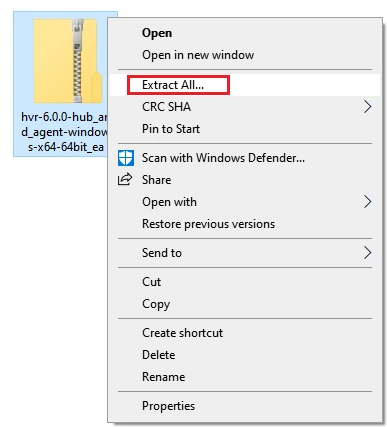
Configure the TCP listening port on which the HVR Hub Server will listen for connection request.
The secure HTTP protocol (HTTPS) is preferred, but this requires a private-key and public-certificate. This pair of files must have been generated for the hub machine's DNS host name, and signed by a certificate trusted by web browsers.
If private-key and public-certificate files are available (e.g. mycert.priv_key and mycert.pub_cert), use them to configure HTTPS:
Create the following directories - hvr_config, etc, cert.
md %HVR_CONFIG%md %HVR_CONFIG%\etcmd %HVR_CONFIG%\etc\certCopy the private-key and public-certificate files into the cert directory, and rename them as hvrhubserver.priv_key, hvrhubserver.pub_cert respectively.
copy mycert.priv_key %HVR_CONFIG%\etc\cert\hvrhubserver.priv_keycopy mycert.pub_cert %HVR_CONFIG%\etc\cert\hvrhubserver.pub_certSet the HTTPS and HTTP ports by using the command hvrhubserverconfig.
hvrhubserverconfig HTTPS_Port=4341 HTTP_Port=4340- Port 4341 and 4340 is recommended for HVR's use of HTTPS and HTTP protocol respectively.
- If HTTPS is configured, then connections to the (unencrypted) HTTP port are simply redirected to the HTTPS port
If the private-key is encrypted, optionally, you can set password for the private-key.
hvrhubserverconfig HTTPS_Private_Key_Password=@promptSupply a password when prompted.
If HTTPS private-key and public-certificate files are not available, configure HTTP instead:
Set the HTTP port by using the command hvrhubserverconfig.
hvrhubserverconfig HTTP_Port=4340- Port 4340 is recommended for HVR's use of HTTP protocol.
- Browser may give warnings that HTTP is insecure. These warnings must be ignored (until HTTPS is configured).
Set up the HVR Hub System, which requires connecting it to its repository database and initializing that database's repository tables. This can be done from a web browser (UI) or from the command-line (CLI).
- Setting up system from browser:
Start the HVR Hub Server by using the command hvrhubserver.
hvrhubserver -acsUnlike the installer-based installation, the ZIP file installation does not automatically configure the HVR Hub Server process to start after a system reboot. You must manually configure auto-start for this process. For instructions, see Configuring HVR Auto-Start on Windows.
In the web browser, connect to the URL shown (e.g. http://mynode:4340/) in the command hvrhubserver output above. The HVR Hub System will be running in a 'setup mode'. Once the system setup steps are completed, the HVR Hub System will automatically exit the 'setup mode'. For more information about setting up the HVR Hub System from browser, see Setting up HVR Hub from Browser.
- Setting up system from command-line (advanced usage). For more information about setting up the HVR Hub System from CLI, see Setting up HVR Hub from CLI.
- Setting up system from browser:
Configure alerts. HVR can send alert notifications if a problem affects replication. Alerts can also be configured to be sent if the replication latency (the delay between capturing a change and delivering that change to the target) exceeds an SLA (Service Level Agreement).
Alerts are sent by a separate process called hvralertmanager, which should be scheduled to run at a fixed frequency (e.g. every 10 minutes).
To check alerts every 10 minutes, create Windows Scheduled Tasks (for example, task is named HVR_Alert).
schtasks /create /sc minute /mo 10 /tn HVR_Alert /tr C:\fivetran\hvr_home\bin\hvralertmanager.exeAlternatively, the Windows Scheduled Tasks can be created using the Windows GUI. Click here for the steps
Open Task Scheduler. This can be accessed from Control Panel ▶ Administrative Tools
Alternatively, Task Scheduler can be accessed by running (Winkey+r) taskschd.msc.
Click Action ▶ Create Task
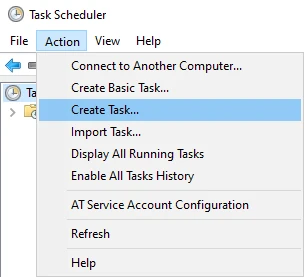
In General tab, enter task Name, and optionally a task Description.
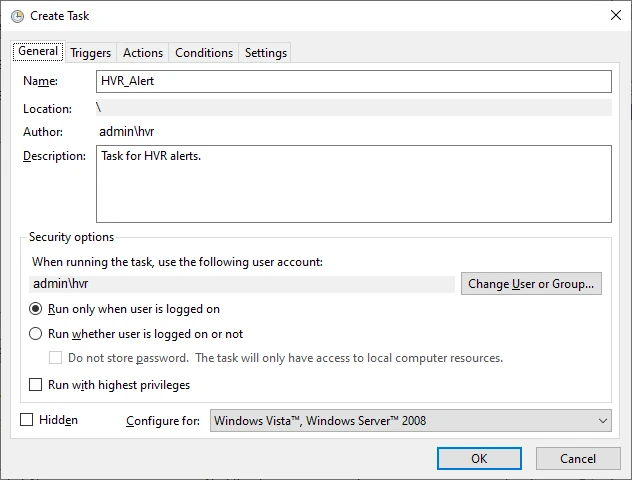
In Actions tab, click New... to open New Action dialog.
Browse and select the directory path for hvralertmanager.exe (available in HVR_HOME\bin) and click OK.
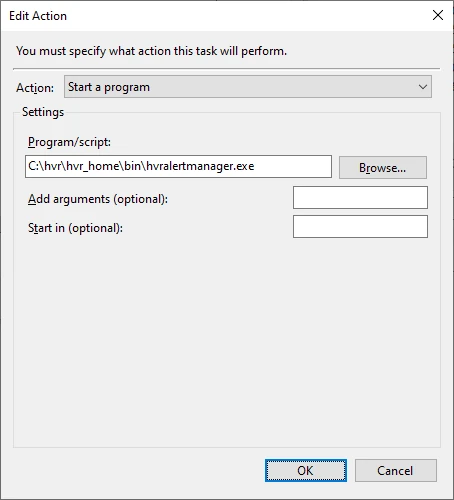
In Triggers tab, click New... to open New Trigger dialog.
Select the required frequency at which this task should be executed. For example, to execute this task every 10 minutes:
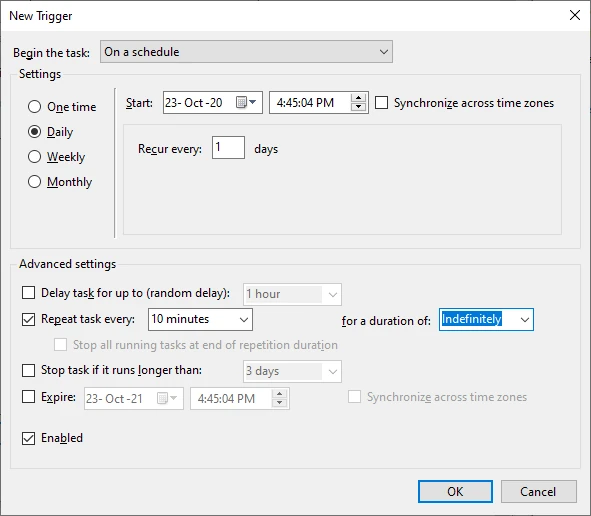
Click OK in Create Task dialog.
To verify that hvralertmanager is running correctly, check 10 minutes later that lines are being written to file alertmanager.out available in HVR_CONFIG\logs directory.
For the steps to configure connection via proxy server, see section Configuring Connection via Proxy Server on Windows.